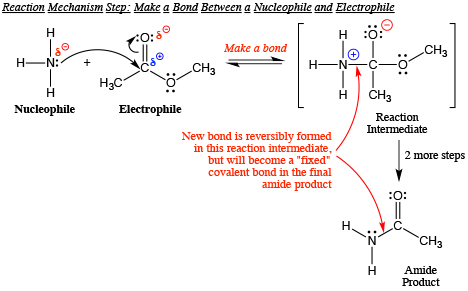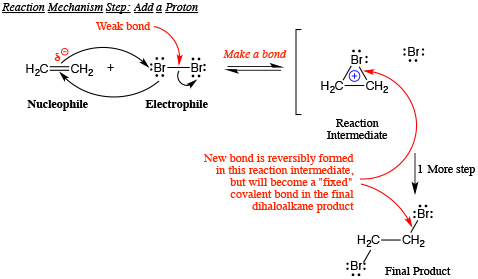Click here for a printer friendly pdf version of this
page
Lewis Bases, Lewis Acids, Brønsted-Lowry Bases, Brønsted-Lowry Acids, Nucleophiles and Electrophiles
Electron-Rich Molecules
Quick summary An electron-rich molecule is called:
A Lewis base when the bond being made is a dative or coordinate bond (in other words relatively weak so that it repeatedly forms and dissociates at or near room temperature).
A Brønsted-Lowry base when the bond being made is to a proton.
A nucleophile when the bond being made is a covalent bond in the product.
Let us take a closer look at related concepts and terminology. One of the key principles of organic chemistry is that molecules with electron-rich areas (partial or full negative charge), generally lone pairs of electrons or in some cases specific bonds such as the pi bonds of alkenes, have important and characteristic patterns of reactivity. Such electron-rich species are described by three different but related terms depending on the type of bond being made and this can be confusing at first.
- The most general description of an electron-rich species is as a Lewis base (Section 4.7 of the book). Being electron-rich, Lewis bases will react with electron-deficient atoms of various types, and the ions or molecules containing such electron-deficient atoms are referred to as Lewis acids. Although some chemists still refer to virtually all electron-rich species as Lewis bases, we will restrict use of the term to situations in which the bond being made is a so-called dative or coordinate bond, in other words, a relatively weak type of bond that repeatedly forms and dissociates at or near room temperature. It might be a good idea to review Lewis acids and Lewis bases in Section 4.7 of the book before proceeding. The new species held together by the coordinate bond is commonly referred to as a Lewis acid-Lewis base complex.
- When the reaction is with a proton source (a Brønsted-Lowry acid such as HCl) so that the new bond is being made to a proton, the electron-rich molecule should be referred to as a Brønsted-Lowry base (Section 4.2 of the book) to indicate the reaction being discussed is a proton-transfer reaction.
- A third important context involves the discussion of reaction mechanisms in which an electron-rich species such as an atom with a lone pair or the pi bond of an alkene reacts with a variety of reagents to make a new covalent bond. Covalent bonds are so stable that once formed in the final product they are considered “fixed”, in other words, they do not repeatedly form and dissociate at or near room temperature. For example, it will be a covalent bond if it forms between C, N, O and H atoms among others. There is an emphasis on “final” in final product. A nuance here is that some of these bonds may reversibly form during a reaction mechanism in the context of a high-energy reaction intermediate, but in the final product they will become “fixed” covalent bonds. When discussing reaction mechanisms and a new covalent bond is formed between an electron-rich atom or bond and an electron-deficient atom, we refer to the electron-rich species as the “nucleophile” and the electron-deficient species as the “electrophile”. The source of the arrow that indicates the new covalent bond is the nucleophile. Although you could correctly refer to the same electron-rich molecule as a Lewis base or even as a Brønsted-Lowery base in different contexts, when making a covalent bond in a reaction mechanism the term “nucleophile” is most appropriate. “Make a new bond between a nucleophile and electrophile” is a very common step in many reaction mechanisms, so it is one of the four common mechanistic steps used throughout the course. Just to be clear, when a reaction mechanism does involve a Brønsted-Lowry acid such as HCl, it is appropriate to refer to the electron-rich species as a Brønsted-Lowry base rather than a nucleophile and this type of mechanism step should be labeled as “Add a proton”.
An important conclusion to draw is that the concepts of “base” and “nucleophile” are closely related. Different terms can be used to describe the same molecule and the correct term is chosen based on the type of bond being made.
Electron-Deficient Molecules
Quick summary An electron-deficient molecule is called:
A Lewis acid when the bond being made is a dative or coordinate bond (in other words relatively weak so that it repeatedly forms and dissociates at or near room temperature).
A Brønsted-Lowry acid when the bond being made is to a proton.
An electrophile when the bond being made is a covalent bond in the product.
Molecules with electron-deficient areas (partial or full positive charge) also have important and characteristic patterns of reactivity. These molecules either have an atom with an unfilled valence (a B or C atom with only 6 electrons in its valence shell) or atoms of low electronegativity such as H or C atoms adjacent to an electronegative atom such as N, O or a halogen. Such electron-deficient species are also described by three different but related terms depending on the type of bond being made.
- The most general description of an electron-deficient species is as a Lewis acid (Section 4.7 of the book). Being electron-deficient, Lewis acids will react with electron-rich atoms or bonds of various types, and the ions or molecules containing such electron-rich atoms or bonds are referred to as Lewis bases. Although some chemists still refer to virtually all electron-deficient species as Lewis acids, we will restrict use of the term to situations in which the bond being made is a so-called dative or coordinate bond, in other words, a relatively weak type of bond that repeatedly forms and dissociates at or near room temperature. In these situations, the electron deficient atom of the Lewis acid often has an incomplete valence shell such as a neutral B atom. It might be a good idea to review Lewis acids and Lewis bases in Section 4.7 of the book before proceeding. The new species held together by the new coordinate bond is commonly referred to as a Lewis acid-Lewis base complex.
- When the Lewis acid is a proton source such as HCl, it is referred to as a Brønsted-Lowry acid to indicate the reaction being discussed is a proton-transfer reaction. In that case, the species accepting the proton is described as a Brønsted-Lowry base (Section 4.2 of the book).
- A third important context involves the discussion of reaction mechanisms in which an electron-deficient molecule reacts with a variety of electron-rich reagents to make stable covalent bonds in the product. When discussing reaction mechanisms and a new covalent bond is formed between an electron-rich atom or bond and an electron-deficient atom, we refer to the electron-rich species as the “nucleophile” and the electron-deficient species as the “electrophile”. The sink for the arrow that indicates the new covalent bond is the electrophile. Although you could correctly refer to the same electron-deficient molecule as a Lewis acid in different contexts, when describing new covalent bond formation in a mechanism the term “nucleophile” is most appropriate. “Make a new bond between a nucleophile and electrophile” is a very common step in many reaction mechanisms, so it is one of the four common mechanistic steps used throughout the course. An added element related to electrophiles is that often a covalent bond must be broken to accommodate the new covalent bond to the nucleophile. Thus, electrophiles often have the required feature of possessing a relatively weak bond that can be broken to create stable molecules or ions (i.e. leaving groups), such as the halogens (Cl2 or Br2) or haloalkanes. Just to be clear, when a reaction does involve the transfer of a proton, the electron-deficient species (i.e. HCl) should be called a Brønsted-Lowry acid and this type of mechanism step should be labeled as “Add a proton”.
An important conclusion to draw is that the concepts of “acid” and “electrophile” are closely related. Different terms can be used to describe the same molecule and the correct term is chosen based on the type of bond being made.
Examples
Study the following examples to help solidify your understanding of the concepts described above. The first three examples show the same electron rich ammonia molecule reacting in three different contexts.
In the first example, ammonia is a Lewis base because it is reacting with the Lewis acid BF3 to form a new coordinate bond in the product Lewis acid-Lewis base complex.

In the second example, ammonia is a Brønsted-Lowry base because it is reacting with the Brønsted-Lowry acid HCl in a proton-transfer reaction.

In the third example, a new bond is being made in the first step of the amide formation reaction mechanism. Note that in the context of the high energy reaction intermediate being formed in the step shown, the new N-C bond is formed reversibly, but in the final amide product, the new bond is covalent. Therefore ammonia is a nucleophile, the ester molecule is an electrophile and the mechanism step is an example of “Make a bond between a nucleophile and electrophile”.

In the fourth example, the relatively electron-rich pi bond of the alkene is making a new bond to bromine in the first step of an electrophilic addition reaction. Therefore, the alkene is a nucleophile and bromine is acting as an electrophile and the mechanism step is an example of “Make a bond between a nucleophile and electrophile”. Note that a lone pair on bromine simultaneously makes a second new bond with the alkene to give the three-membered ring reaction intermediate. Also notice that the Br2 is an electrophile because it has a relatively weak bond between the Br atoms due to the presence of so many lone pairs (that repel each other).

In the fifth example, the alkene is reacting with the Brønsted-Lowry acid HCl in the first step of an electrophilic addition reaction. Therefore, the alkene is a Brønsted-Lowry base and the mechanism step is an example of “Add a proton”.






